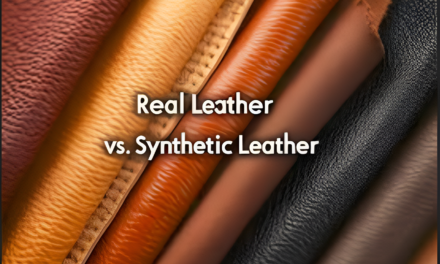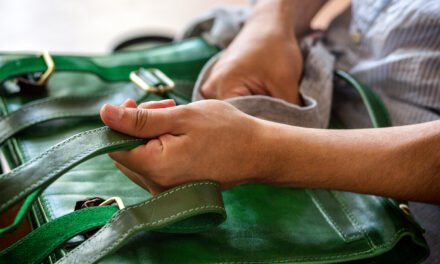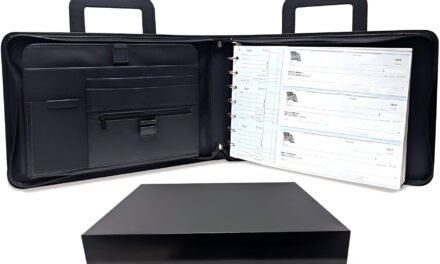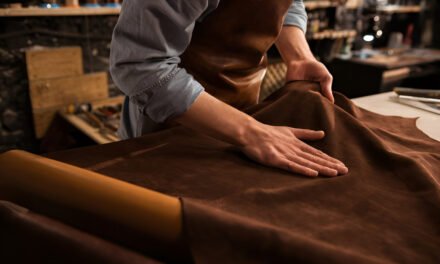Processed leather is classified into different grades based on the quality of the hide, the processing techniques, and the portion of the hide used. These grades determine the durability, texture, price, and end-use of the leather. Understanding these classifications helps manufacturers and consumers choose the right type of leather for their specific needs.
1. Full-Grain Leather
Grade: Highest Quality
- Definition: Full-grain leather is made from the topmost layer of the hide, which retains its natural grain and imperfections. It undergoes minimal processing, preserving its strength, durability, and natural beauty.
- Features:
- Most durable and long-lasting leather.
- Develops a rich patina (natural shine) over time.
- Retains natural marks, scars, and grain patterns, giving it a unique look.
- Usage:
- Premium products like briefcases, luxury bags, furniture, and footwear.
- Pros:
- Highly durable and breathable.
- Ages beautifully with proper care.
- Cons:
- Expensive due to its quality.
- Less uniform in appearance because of natural imperfections.
2. Top-Grain Leather
Grade: High Quality
- Definition: Top-grain leather is also derived from the top layer of the hide but is sanded or buffed to remove surface imperfections, resulting in a more uniform appearance.
- Features:
- Smooth and polished surface.
- Slightly thinner and more flexible than full-grain leather.
- Retains durability but sacrifices some breathability compared to full-grain.
- Usage:
- High-quality bags, portfolios, jackets, and furniture.
- Pros:
- Uniform and clean appearance.
- More affordable than full-grain leather.
- Cons:
- Less breathable due to surface treatment.
- Slightly less durable compared to full-grain.
3. Genuine Leather (Corrected Grain or Split Leather)
Grade: Mid-Quality
- Definition: Genuine leather is made from the lower layers of the hide after the top grain is removed. It is often corrected and treated with coatings to improve appearance and feel.
- Features:
- Less durable and thinner than top-grain or full-grain leather.
- The surface is often embossed with artificial grain patterns.
- More affordable and widely available.
- Usage:
- Budget-friendly leather goods, wallets, belts, and entry-level bags.
- Pros:
- Affordable and versatile.
- Uniform appearance due to artificial finishes.
- Cons:
- Not as durable or breathable as higher grades.
- Wears out faster and does not develop a patina.
4. Split Leather
Grade: Lower Quality
- Definition: Split leather is created from the lower layers of the hide after the top layer (grain) has been removed. It is often coated with polyurethane (PU) or other synthetic layers to improve strength and appearance.
- Features:
- Soft and pliable but less durable.
- Commonly used as a base material with synthetic coatings.
- Prone to peeling and cracking over time.
- Usage:
- Low-cost leather products, linings, or suede finishes.
- Pros:
- Economical and widely available.
- Lightweight and easy to handle.
- Cons:
- Poor durability and prone to damage.
- Not as breathable or visually appealing as higher grades.
5. Bonded Leather
Grade: Lowest Quality
- Definition: Bonded leather is made from leather scraps and fibers that are bonded together using adhesives and covered with a synthetic layer. It contains a small percentage of actual leather.
- Features:
- The least expensive form of leather.
- Uniform appearance, often artificially textured to mimic real leather grain.
- Prone to peeling, cracking, and disintegration with use.
- Usage:
- Low-cost furniture, bookbinding, promotional goods, and small accessories.
- Pros:
- Very affordable.
- Available in various colors and patterns.
- Cons:
- Lacks durability and breathability.
- Contains very little real leather.
6. Suede Leather
Specialized Grade
- Definition: Suede is made from the underside of the hide, giving it a soft, velvety texture. It is typically created by splitting the hide.
- Features:
- Luxuriously soft feel with a matte finish.
- Less durable and prone to staining.
- Usage:
- Fashion products like shoes, jackets, gloves, and some accessories.
- Pros:
- Unique texture and visual appeal.
- Flexible and lightweight.
- Cons:
- Requires careful maintenance (sensitive to water and stains).
- Less durable than full-grain or top-grain leather.
7. Nubuck Leather
Specialized Grade
- Definition: Nubuck is a form of top-grain leather that has been buffed to achieve a velvety texture, similar to suede but with greater durability.
- Features:
- Soft, fine grain with a luxurious look.
- More durable than suede due to its top-grain origin.
- Usage:
- High-end shoes, bags, and upholstery.
- Pros:
- Elegant appearance and soft texture.
- More durable than suede.
- Cons:
- Prone to staining and requires regular care.
Conclusion
Processed leather is classified into different grades based on the portion of the hide used, the processing method, and the finished quality.
- Full-grain and top-grain leathers are the highest-quality options, offering unmatched durability and luxury.
- Genuine leather and split leather offer affordability but compromise on longevity.
- Lower-grade options like bonded leather cater to budget-conscious markets but lack durability.
Understanding these classifications helps manufacturers and consumers select the right type of leather for specific applications, balancing quality, price, and functionality.
Hashtags
#LeatherLovers #SustainableLeather #LeatherFacts #LeatherCareTips #LeatherFashion #LeatherTrends #LeatherProducts #LeatherAccessories #LeatherArtisans #LeatherDesign #LeatherHistory #LeatherCulture #LeatherCommunity #LeatherExpertise #LeatherKnowledge #LeatherPassion #LeatherAppreciation #LeatherInspiration #LeatherStyle #LeatherObsessed #LeatherAddict







